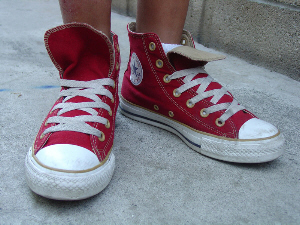 Editor’s note: We all know shoes leave a footprint, but probably haven’t given much thought to the environmental footprint created by shoe manufacturing. Travis Brown, a student in Professor Simran Sethi’s Media and the Environment course at the University of Kansas, takes a look at the impact of what we put on our feet. This post was originally published to the course blog on Monday, March 10, 2008, and on Triplepundit on Thursday, March 13, 2008.
Editor’s note: We all know shoes leave a footprint, but probably haven’t given much thought to the environmental footprint created by shoe manufacturing. Travis Brown, a student in Professor Simran Sethi’s Media and the Environment course at the University of Kansas, takes a look at the impact of what we put on our feet. This post was originally published to the course blog on Monday, March 10, 2008, and on Triplepundit on Thursday, March 13, 2008.
America has a shoe problem.
2,286,472,000 shoes were purchased in the U.S. in 2005 according to the American Apparel & Footwear Association. There were 297,821,175 Americans alive at the end of 2005. That’s 7.67 shoes per person. Now I realize that I am a man and therefore do not understand the true glory of shoes, but this seems a little absurd. Think of all the different materials that go into making shoes and their packaging. Think of all the different places that those materials come from. Then think of where the shoes are made and how far they travel. In 2005, only 1.4% of consumed shoes were manufactured in America. 84.2% of American bought shoes that were made in China.
Just take a gander at this trend throughout the past few decades.

Graph: The American Apparel & Footwear Association
And that’s not the half of it. Read this National Geographic Green Guide article to learn the true horrors behind the shoe industry.
Not only do your shoes affect your footprint, they significantly alter your carbon footprint as well. Oh my!
But many shoe brands are working to become more eco-friendly. Simple now uses sustainable materials such as organic cotton, water based glue, recycled car tires, and recycled plastic bottles when making their shoes.
Timberland is also making great strides to green their company along with the entire shoe industry. In addition to using organic and recycled materials in some of their shoes they also pay workers to complete 40 hours of community service each year. Also, all there shoe boxes now carry a “nutrition label” that tell the environmental impact of each shoe. The labels may not say where each of the materials came from our other important matters pertaining to each pair’s impact, but the intentions are still admirable. Chief executive of Timberland, Jeffry B. Swartz hopes that other brands will adopt similar labels so that customers will compare eco-impact when shopping for shoes.
Huzzah to those who are trying to establish a firm footing in the fight for sustainability, but for the most part the movement to green the shoe industry is still lacking sole.
Maybe what the shoe biz needs is a little help from the hip-hop world. After all, RUN DMC did wonders for Adidas and The Pack’s song “Vans” boosted the sales of the already successful skateshoe brand.
I’m strutting down the street in my eco-friendly kicks
I don’t like toxic runoff cause it makes the fishies sick.
What do you think?
No?
Fine. I’ll stick to blogging.
Stay tuned for the next installment — Green Footing Part Deux: Local Shoe Subdue (on Ecolocalizer)
Image credit: Wikimedia Commons


Chad
The Steve Nash “trash talk” shoe…for environmental ballers: http://www.cbc.ca/consumer/story/2008/02/14/nash-trash-talk.html
Sharon Troy
Hey, I’m a woman, and I don’t get the “glory of shoes” either. I was kickin’ around in my Chuck T’s for six years until they gave up on me last month.
Anyway, now I buy from MooShoes, which are not only eco-friendly but also free of animal products. My new sneakers are made of hemp.
http://www.mooshoes.com/
Harry
I wear Earthkeepers Thong footwear from Timberland. It is fashionable eco-friendly footwear. Leather insole is provided with cushioning, support and breathability..The company claims that the Earthkeepers collection contains durable, high-quality footwear made in an environmentally-friendly way. I am feeling very comfortable wearing it. It is too light.